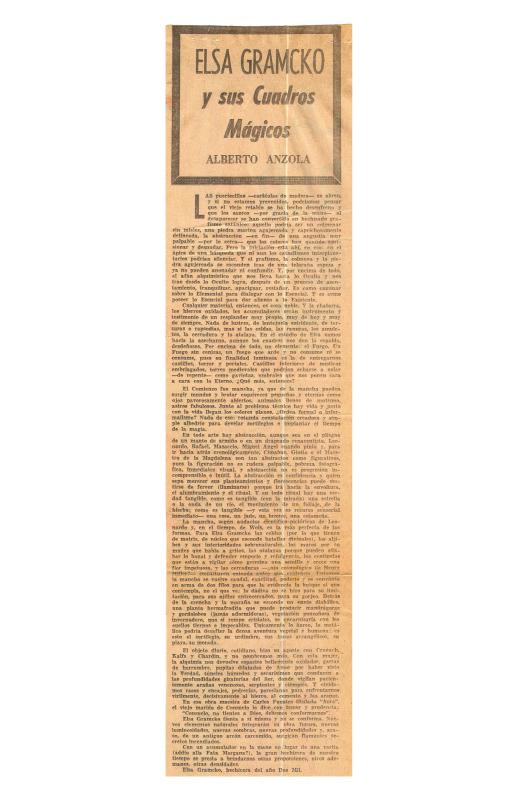This essay written by Elsa Gramcko (1925–1994) explains her creative process; it was published in the volume El artista en su taller [The Artist in Her Workshop], which was compiled by the poet, draftsmen, and art critic Juan Calzadilla. It is written from a decidedly optimistic viewpoint, free of the repudiation of her later years. In this stage of her artistic career, Gramcko was still in close communion with her work, which she saw as an extension of her “yo” [self]. Her work and her relationship with the material was the highest expression of her interior “yo” as the physical manifestation of her psychological state. This Venezuelan artist fully identified with her work because she considered it an integral part of herself. The whole of Gramcko’s creative philosophy, the reasons that drove her to create a work, as well as the explanation and justification of her creative task, are captured in this text—which is therefore its importance. The fundamental philosophical and psychological concepts necessary for understanding Gramcko’s artistic theory are also explained within. The essay stands out for its strong criticism of dehumanized art, that which only seeks public acceptance loses the creative impulse. In her judgment, artistic creation ceases to have meaning when the interior world of the artist loses its individuality and integrity, separating itself from its “verdadero significado” [true meaning] as a tangible manifestation of the inner being of the artist. This document is undoubtedly an essential text that represents a primary source that makes known the artist’s creative philosophy, rather than being another’s person subjective interpretation.
In this period, Gramcko was not at odds with her art nor with the art world in general; on the contrary, she seems very satisfied when speaking of creation. Not counting the interviews conducted by Juan Calzadilla and Teresa Alvarenga, it is one of the few texts written directly by Gramcko.
[To access other critical essays and interviews with the artist, see the ICAA digital archive: essay by José Gómez Sicre published in 1959, “Elsa Gramcko of Venezuela” (doc. no. 1222685); the biographical sketch by Oswaldo Trejo published in 1966, “Elsa Gramcko” (doc. no. 1153620); the text by Alberto Anzola published in 1968, “Elsa Gramcko y sus cuadros mágicos” [Elsa Gramcko and Her Magical Paintings] (doc. no. 1153668); the article by Robert Guevara, published in El Nacional in 1969, “Abstractos inéditos de Elsa Gramcko” [Unpublished Abstracts of Elsa Gramcko] (doc. no. 1163749); the essay by Juan Calzadilla published in 1969, “Elsa Gramcko: la atracción de las texturas”[Elsa Gramcko: The Attraction of Textures] (doc. no. 1153589); the critique by Clara Diament Sujo, “Elsa Gramcko,” (doc. no. 1153604); “Entrevista con Elsa Gramcko” [Interview with Elsa Gramcko] (doc. no. 1152673); the critique by Teresa Alvarenga published in 1979, “Elsa Gramcko por ahora el silencio” [Elsa Gramcko Silence for Now] (doc. no. 1153652); and the text by Juan Carlos López Quintero published in 1997, [Elsa Gramcko: An Alchemist for Our Time] (doc. no. 1152657).









